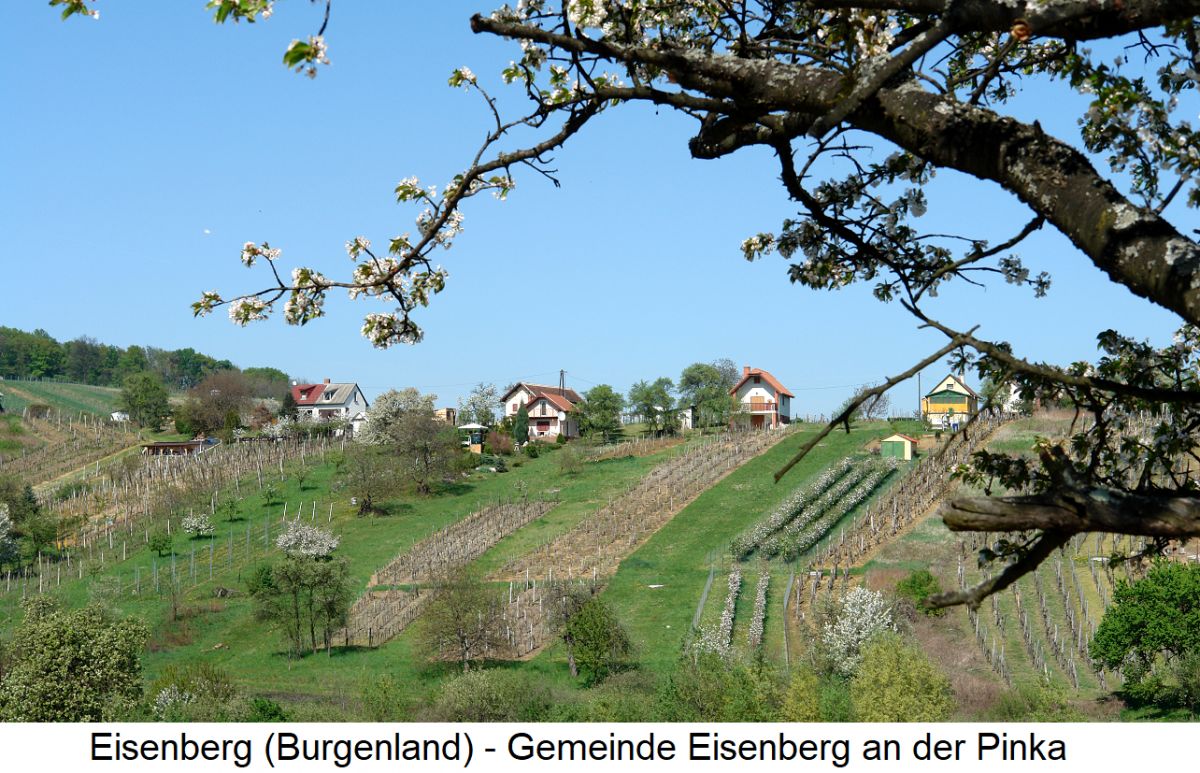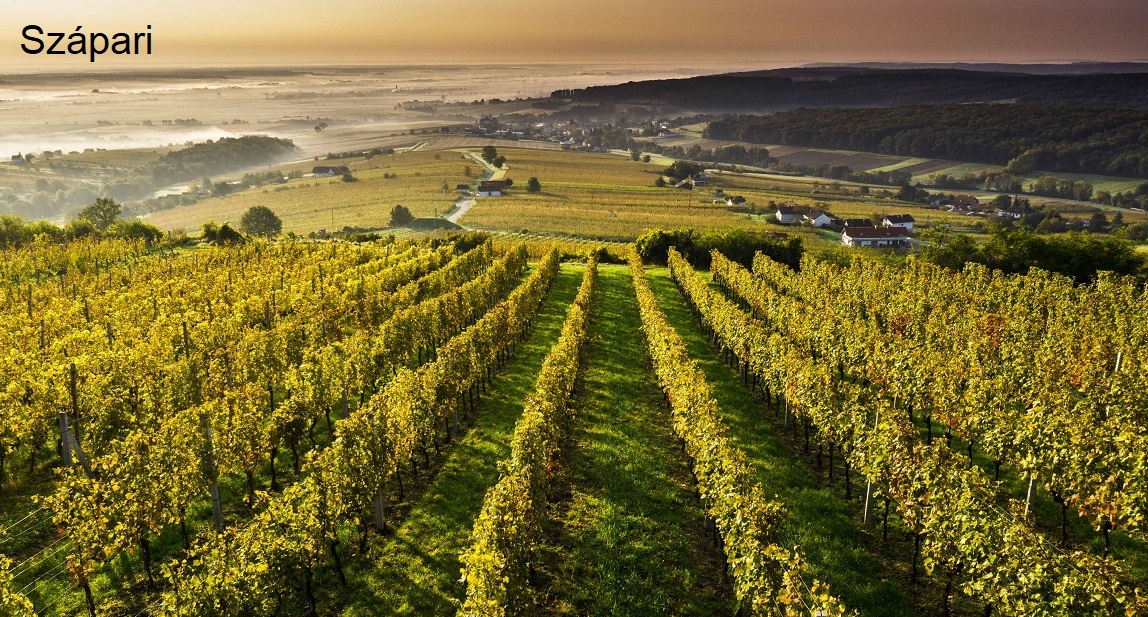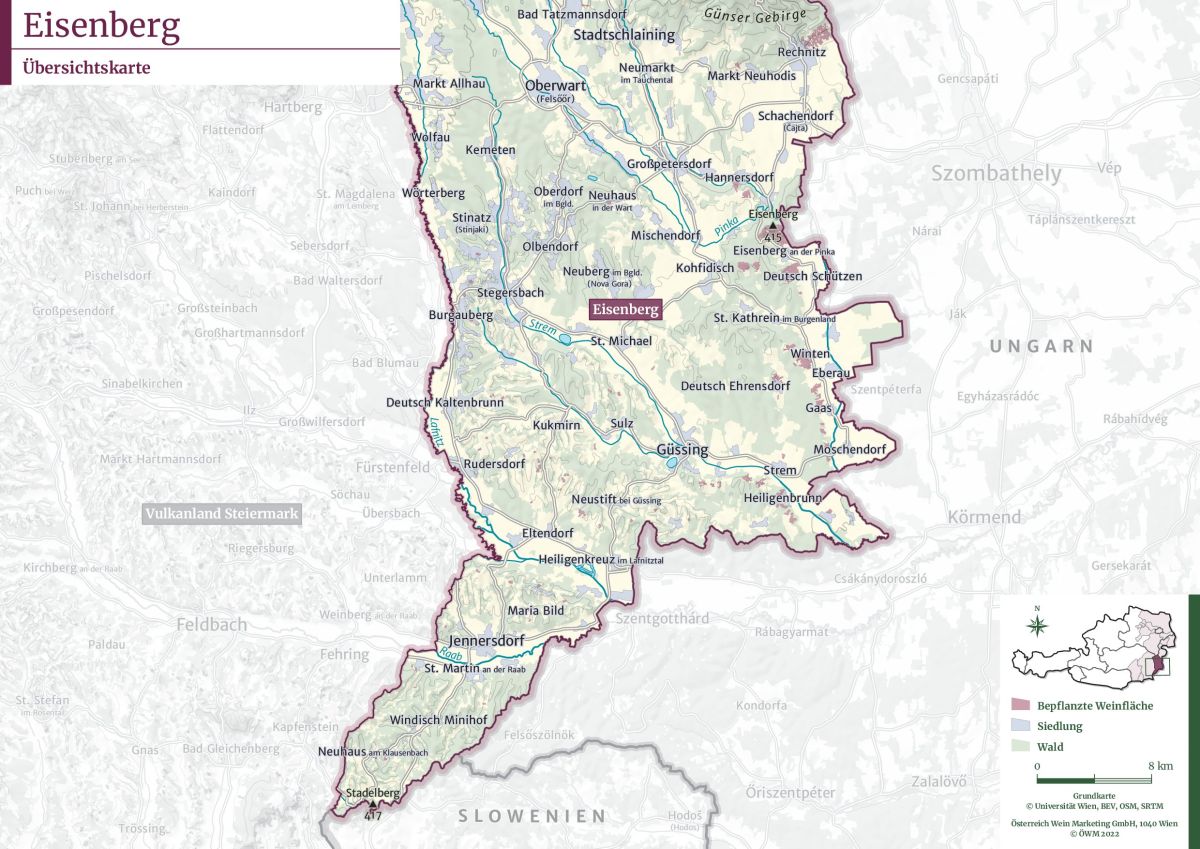Results
2,284 Results
Loading more Results ...
Loading more Results ...
Austria Burgenland
Eisenberg
| Eisenberg |
Description to Eisenberg
One of the six specific wine-growing regions in the Austrian province or generic wine-growing region of Burgenland. Restructuring took place in 2016 with changes to the designations and area boundaries. The former name Südburgenland was replaced by Eisenberg. The new name was chosen because the "ü" could have a disruptive effect when exporting and "Eisenberg" was already the name of the traditional wine-growing region in the past. From the 12th century onwards, the Cistercian monastic order in particular contributed a great deal to the development of viticulture here. After the phylloxera catastrophe, the Uhudler speciality was born here at the beginning of the 20th century.

Climate & soils
Eisenberg differs from the northern wine-growing regions of Burgenland in terms of its climatic conditions, particularly the higher rainfall. The mild, Pannonian climate is characterised by intense sunshine. The forests favour cooling at night. The soils consist mainly of ferruginous, clayey loam.

Wine-growing communities & vineyards
The area extends south of the Günser Bergland and lies on the border with Hungary. The Pinkatal Wine Route runs from the largest municipality Rechnitz in the north along the border via the municipalities Eisenberg an der Pinka with the vineyards Csaterberg, Hummergraben, Paigl, Reihburg, Saybritz and Szápari, as well as Deutsch-Schützen with the vineyards Bründlgfangen, Fasching, Ratschen and Weinberg to the south. Other municipalities are Badersdorf, Eberau, Güssing, Hannersdorf, Heiligenbrunn (with Uhudler wine shop), Kohfidisch, Moschendorf (with wine museum and Uhudler wine shop) and Strem.

Grape variety index
In 2022, the vineyards covered a total of 511 hectares of vines. Compared to 2017 with 515 hectares, this was a reduction of 4 hectares (0.8%). The share of white wine varieties is 48%, the share of red wine varieties 52%. Blaufränkisch dominates with over a third, followed by Welschriesling, Zweigelt and Merlot.
Grape variety
|
in Austria
|
colour |
HA
|
%
|
HA
|
%
|
| Blaufränkisch | - | red | 157 | 30,7 | 185 | 35,8 |
| Welschriesling | - | white | 76 | 14,8 | 99 | 19,1 |
| Zweigelt | Blauer Zweigelt, Rotburger | red | 22,4 | 4,4 | 32 | 6,2 |
| Merlot | - | red | 20,5 | 4,0 | 20 | 3,9 |
| Chardonnay | Morillon - not used in Bgld | white | 12,1 | 2,4 | 7,4 | 1,4 |
| Grüner Veltliner | White plum | white | 12 | 2,3 | 28 | 5,5 |
| White Burgundy | Pinot Blanc, Klevner | white | 10,5 | 2,1 | 12,2 | 2,4 |
| Sauvignon Blanc | Muscat Sylvaner | white | 9,8 | 1,9 | 6,3 | 1,2 |
| Cabernet Sauvignon | - | red | 9,3 | 1,8 | 11,7 | 2,3 |
| Pinot Noir | Pinot Noir, Pinot Noir | red | 5,2 | 1 | 6,5 | 1,3 |
| Muscat | Yellow M., Red M. / Muscat Blanc | white | 5,1 | 1 | 4,3 | 0,8 |
| Muscaris | - | white | 4,2 | 0,8 | - | - |
| White Riesling | Riesling Rhine Riesling | white | 3,6 | 0,7 | 8,1 | 1,6 |
| Müller-Thurgau | Rivaner | white | 2,7 | 0,5 | 7,7 | 1,5 |
| Blue Burgundy | - | red | 2,7 | 0,5 | 4,2 | 0,8 |
| Syrah | Shiraz | red | 2,5 | 0,5 | 2,8 | 0,5 |
| Furmint | - | white | 1,6 | 0,3 | - | - |
| Scheurebe | Seedling 88 | white | 1,4 | 0,3 | 3,1 | 0,6 |
| Traminer | - | white | 1,3 | 0,2 | - | - |
| Muscat Ottonel | - | white | 1,3 | 0,2 | - | - |
| Cabernet Franc | - | red | 0,9 | 0,2 | 0,9 | 0,2 |
| Roesler | - | red | 0,8 | 0,1 | - | - |
| Gold muscatel | - | white | 0,7 | 0,1 | - | - |
| Blossom muscatel | - | white | 0,5 | 0,1 | - | - |
| Souvignier Gris | - | white | 0,5 | 0,1 | - | - |
| Rotburger | - | white | 0,3 | - | - | - |
| Gold burger | - | white | 0,2 | - | 2,6 | 0,5 |
| St Laurent | - | red | 0,2 | - | - | - |
| Blauer Portugieser | - | red | 0,2 | - | - | - |
| Bouvier | - | white | 0,1 | - | - | - |
| Neuburger | - | white | 0,1 | - | - | - |
| Rathay | - | red | 0,1 | - | - | - |
| Zierfandler | - | white | 0,1 | - | - | - |
| remaining varieties | - | white/red | 145 | 28 | 75 | 14,5 |
WHITE VARIETIES |
|
|
245 |
48 |
246 |
48 |
RED VARIETIES |
|
|
266 |
52 |
269 |
52 |
TOTAL |
|
|
511 |
|
515 |
|
DAC system
The Eisenberg DAC origin-controlled quality level was introduced from the 2008/2009 vintage. All other quality wines must be marketed with the Burgenland designation of origin, while regional wines must be marketed under the wine-growing region designation Weinland. In addition to the generally applicable DAC conditions, the following rules apply:
The red wines must have been made from the quality wine grape variety Blaufränkisch; any blending with another grape variety is not permitted. The bottle must be labelled with a specific capsule, the appearance of which is determined by the regional wine committee. The date for the application to obtain the state inspection number is staggered. If the decision is favourable (usually within a week), the wine may be marketed. There are two quality categories:
Classic: The wines can be matured in stainless steel tanks or in wooden barrels, but they must have no or only a barely noticeable woody flavour (toast aroma). The alcohol content must be 12.5 or 13% vol. The closure must be a screw cap or natural cork. The application may be submitted from 1 August of the year following the harvest at the earliest (a decision is usually made within a week).
Reserve: The wine must be matured in traditional large wooden barrels or in barriques, i.e. wood flavours are permitted. The alcohol content must be at least 13% vol. Only natural cork stoppers are permitted. The application may be submitted from 1 February of the second year following the harvest at the earliest.
single vineyard wines From vintage 2022, wines made from Welschriesling with a vineyard designation may bear the designation Eisenberg DAC.
Producers
The regional winegrowers' association Weinidylle Südburgenland organises marketing activities and quality-enhancing measures. Well-known producers include Groszer Wein, Jalits, Kopfensteiner, Körper Erich, Krutzler Reinhold, Schiefer Uwe, Schützenhof, Unger Gerald, Wachter-Wiesler, Wallner Gerhard, Weber Alfred and Weninger Franz.
Eisenberg and map: © ÖWM - Egon Mark
Szápari: © RossWeinberg
More information in the magazine
- Wines with a special flavour Wine-growing regions in Austria: Eisenberg
- The land of Blaufränkisch Wine-growing regions in Austria: Mittelburgenland
- Delightful border region Wine-growing regions in Austria: Rosalia
- In Focus: Grüner Veltliner The elegant ones are coming
- Terroir and landscapes in Burgenland At the centre of the Blaufränkisch universe
- BEST OF Burgenland Much new on old shores
- Austria In Focus Burgenland
- Mittelburgenland DAC Fruity, spicy, unmistakable Blaufränkisch
- Travel diary Burgenland Travel diary Burgenland
- The collections and discoveries of the year Tasting season 2023/2024